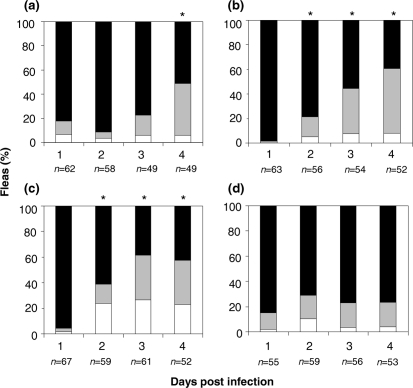Fig. 2.
Percentages of O. montana that were uninfected, infected with high bacterial loads (>104) or infected with low bacterial loads (<104) at 1–4 days p.i. Fleas received an infectious blood meal with Y. pestis: (a) parent strain, (b) biofilm-negative strain, (c) biofilm-reduced strain and (d) biofilm-overproducing strain. The infected fleas were then allowed to feed on naïve mice for 1–4 days p.i. Fleas taking blood meals on naïve mice were harvested after the blood feed, and it was determined whether their bacterial load was high (>1×104 c.f.u. per flea; black bar), low (>0, but <1×104 c.f.u. per flea; grey bar) or zero (0 c.f.u. per flea; white bar). An asterisk indicates that the percentage of fleas harbouring >1×104 c.f.u. Y. pestis was significantly different (P<0.05) from that of fleas carrying <1×104 c.f.u. of the same strain on day 1 p.i., as determined by two-tailed Fisher's exact test.

